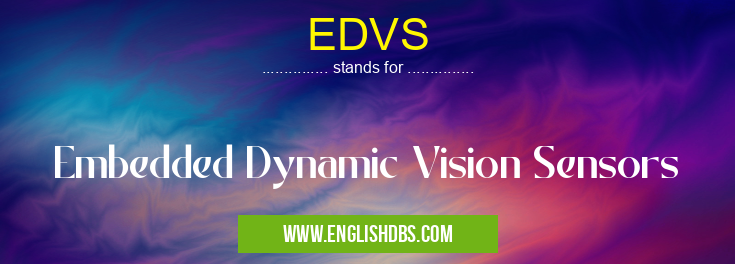What does EDVS mean in UNCLASSIFIED
Embedded Dynamic Vision Sensors (EDVS) are a type of neuromorphic camera that mimics the human eye's ability to process visual information in real-time. They are designed to detect and respond to changes in the visual scene, making them ideal for applications in robotics, autonomous vehicles, and surveillance systems.

EDVS meaning in Unclassified in Miscellaneous
EDVS mostly used in an acronym Unclassified in Category Miscellaneous that means Embedded Dynamic Vision Sensors
Shorthand: EDVS,
Full Form: Embedded Dynamic Vision Sensors
For more information of "Embedded Dynamic Vision Sensors", see the section below.
Key Features
- High Dynamic Range (HDR): EDVS cameras have a wide dynamic range, allowing them to capture images in both bright and dark conditions without overexposure or underexposure.
- Low Latency: They process visual information with extremely low latency, enabling real-time decision-making and control.
- Event-Based: EDVS cameras generate event data, which consists of only the pixels that have changed since the last update. This data is significantly smaller than traditional frame-based video, resulting in lower bandwidth requirements and faster processing times.
- Energy Efficiency: EDVS cameras consume very little power compared to traditional cameras, making them suitable for battery-powered applications.
- Robustness: They are highly resistant to noise and interference, ensuring reliable operation in challenging environments.
Applications
EDVS cameras have a wide range of applications, including:
- Autonomous Vehicles: Collision detection, obstacle avoidance, and navigation
- Robotics: Object recognition, SLAM (Simultaneous Localization and Mapping), and motion control
- Surveillance: Intrusion detection, object tracking, and event-based alerting
- Industrial Automation: Quality control, machine vision, and process monitoring
- Healthcare: Medical imaging, gesture recognition, and patient monitoring
Essential Questions and Answers on Embedded Dynamic Vision Sensors in "MISCELLANEOUS»UNFILED"
What are Embedded Dynamic Vision Sensors (EDVS)?
EDVS are a type of image sensor that is designed for low-power and high-speed image capture. They are often used in embedded systems, such as drones, robots, and autonomous vehicles. Unlike traditional image sensors, EDVS do not capture full images at a fixed frame rate. Instead, they output a stream of events that represent changes in the scene. This makes them very efficient for applications where only changes in the scene are of interest.
How do EDVS work?
EDVS typically use an array of pixels that are each equipped with a photodiode and a comparator. When the light intensity on a pixel changes, the photodiode generates a current that is compared to a threshold by the comparator. If the current exceeds the threshold, the comparator outputs an event. The events are then output as a stream of data.
What are the advantages of using EDVS?
EDVS offer several advantages over traditional image sensors, including:
- Low power consumption: EDVS only consume power when there is a change in the scene, making them very efficient for battery-powered applications.
- High speed: EDVS can capture events at very high speeds, making them ideal for applications where fast motion is of interest.
- Low latency: EDVS output events with very low latency, making them ideal for applications where real-time response is critical.
- Small size: EDVS are typically very small and lightweight, making them ideal for use in embedded systems.
What are the disadvantages of using EDVS?
EDVS also have some disadvantages, including:
- Limited resolution: EDVS typically have a lower resolution than traditional image sensors.
- Noise: EDVS can be noisy, especially in low-light conditions.
- Motion blur: EDVS can suffer from motion blur if the scene is moving too quickly.
What are some applications for EDVS?
EDVS are used in a variety of applications, including:
- Motion detection: EDVS can be used to detect motion in a scene, making them ideal for applications such as security and surveillance.
- Object tracking: EDVS can be used to track objects in a scene, making them ideal for applications such as robotics and autonomous vehicles.
- Gesture recognition: EDVS can be used to recognize gestures, making them ideal for applications such as human-computer interaction.
- Event-based cameras: EDVS can be used as event-based cameras, which output a stream of events that represent changes in the scene. This makes them ideal for applications where only changes in the scene are of interest.
Final Words: EDVS cameras are a promising technology that offers significant advantages over traditional cameras. Their unique combination of high dynamic range, low latency, event-based data, energy efficiency, and robustness makes them well-suited for a wide range of applications in the fields of robotics, autonomous vehicles, surveillance, industrial automation, and healthcare. As the technology continues to develop, we can expect to see even more innovative and groundbreaking applications for EDVS cameras in the future.
